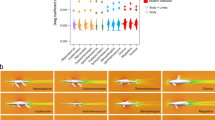Abstract
ORGANISMS with a body mass of more than one gram and which live at the air–water interface generally support their weight with their buoyant bodies. The maximum swimming speed these animals can attain is limited by wave-making resistance1–3. For high-speed progression across a body of water, shore birds and basilisk lizards (Basiliscus basiliscus) support their bodies above the water surface by repeatedly striking the surface with their feet. Here we investigate the mechanism of support in moderately sized basilisk lizards (about 90 g) by combining hydrodynamic measurements of a physical model of the lizards' feet with an analysis of video records of foot movements. We find basilisks of intermediate size obtain little support for their body weight by slapping the water surface; most of the support comes from stroking the foot downwards while expanding an air cavity underwater. The lizard minimizes downward forces by pulling its foot upward before the cavity collapses.
This is a preview of subscription content, access via your institution
Access options
Subscribe to this journal
Receive 51 print issues and online access
$199.00 per year
only $3.90 per issue
Buy this article
- Purchase on Springer Link
- Instant access to full article PDF
Prices may be subject to local taxes which are calculated during checkout
Similar content being viewed by others
References
Prange, H. D. & Schmidt-Nielsen, K. J. exp. Biol. 53, 763–777 (1970).
Fish, F. E. Physiol. Zool. 55, 180–189 (1982).
Harvald, Sv. Aa. Resistance and Propulsion of Ships (Krieger, Malabar, FL, 1991).
Rand, A. S. & Marx, H. Copeia 1, 230–233 (1967).
Laerm, J. Ecology. 55, 404–411 (1974).
van Devender, R. W. in Costa Rican Natural History (ed. Janzen, D. H.) 379–380 (Univ. Chicago Press, Chicago, 1983).
Glasheen, J. W. thesis, Harvard Univ. (1995).
Johnson, T. P., Swoap, S. J., Bennett, A. F. & Josephson, R. K. J. exp. Biol. 174, 199–213 (1993).
Armstrong, L. E., Costill, D. L. & Gehlsen, G. Track Techn. 87, 2780–2782 (1984).
Kyle, C. R. & Caiozzo, V. J. Eur. J. appl. Physiol. 54, 99–103 (1985).
Glasheen, J. W. & McMahon, T. A. Physics of Fluids (in the press).
Author information
Authors and Affiliations
Rights and permissions
About this article
Cite this article
Glasheen, J., McMahon, T. A hydrodynamic model of locomotion in the Basilisk Lizard. Nature 380, 340–342 (1996). https://doi.org/10.1038/380340a0
Received:
Accepted:
Issue Date:
DOI: https://doi.org/10.1038/380340a0
This article is cited by
-
Scale dependence in hydrodynamic regime for jumping on water
Nature Communications (2023)
-
Experimental Study of a Sphere Bouncing on the Water
Journal of Marine Science and Application (2021)
-
Position detection method and hydrodynamic characteristics of the water entry of a cylinder with multidegree motion
Experiments in Fluids (2020)
-
Water walking as a new mode of free surface skipping
Scientific Reports (2019)
-
Controllable water surface to underwater transition through electrowetting in a hybrid terrestrial-aquatic microrobot
Nature Communications (2018)
Comments
By submitting a comment you agree to abide by our Terms and Community Guidelines. If you find something abusive or that does not comply with our terms or guidelines please flag it as inappropriate.



